#22: Genies in the Golden Age
Various artists & pictures from Arabian Nights, Illustrated, edited by Jeff A. Menges
This analysis copyright 2010, Scott M. McDaniel
Welcome folks! We’ve got a massive cage match for you today on RAW, the Real Artist Wrestling smackdown! You decide the winner! And will I please drop the lame announcing thing with all the exclamation points! Yes!
Rather than analyzing a single illustration this time we’re going to look at six illustrations of the exact same scene from the Arabian Nights. From the Tale of the Fisherman and the Genie:
Then he threw his nets for the fourth time. When he thought he had a fish he drew them in with a great deal of trouble. There was no fish however, but he found a yellow pot, which by its weight seemed full of something, and he noticed that it was fastened and sealed with lead, with the impression of a seal. He was delighted. “I will sell it to the founder,” he said; “with the money I shall get for it I shall buy a measure of wheat.”
He examined the jar on all sides; he shook it to see if it would rattle. But he heard nothing, and so, judging from the impression of the seal and the lid, he thought there must be something precious inside. To find out, he took his knife, and with a little trouble he opened it. He turned it upside down, but nothing came out, which surprised him very much. He set it in front of him, and whilst he was looking at it attentively, such a thick smoke came out that he had to step back a pace or two. This smoke rose up to the clouds, and stretching over the sea and the shore, formed a thick mist, which caused the fisherman much astonishment. When all the smoke was out of the jar it gathered itself together, and became a thick mass in which appeared a Genie, twice as large as the largest giant. When he saw such a terrible-looking monster, the fisherman would like to have run away, but he trembled so with fright that he could not move a step.
These days we share a defined idea of what a genie looks like. The visual language is fairly set. During the golden age of American illustration though they didn’t necessarily have those preconceptions. Below we’ll look at how Will and Frances Brundage, René Bull, Edmund Dulac, Charles Folkard, H.J. Ford, and Maxfield Parrish conceived of and presented the scene above.
All they really had to work with was the text of the stories, and possibly the knowledge that according to Islam God created genies (djinn) from fire as he similarly created humans from the clay of the earth.
Will and Frances Brundage, 1893
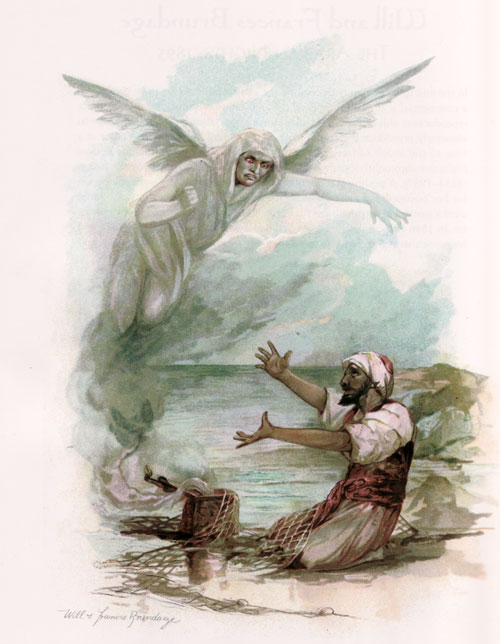
What do you notice right off the bat? For me it was that the genie looks more like an angel to me than a genie. Since when do they have wings? The second thing I noticed was the palette. The technique was chromolithography, which means that a lithographer interpreted the colors of the original painting for widespread reproduction. Still, it’s a very light picture with only a nod to the billowing dark smoke.
Each artist had to decide on a focus for their piece. As you’ll see, some made it a reaction shot of the fisherman and played down the genie. Their intent – I believe – is to give the viewer an emotional connection to the situation. We’re to empathize with the stunned fisherman. Others focus on the grandeur or fantastic aspect of the genie. In those we’re supposed to experience the same awe that the fisherman felt, but the real object of interest is the creature. The Brundages tried to accomplish both objectives with this painting.
The basic composition is a loop, with the genie forming an arc as it emerges from the vessel. It reaches toward the fisherman with outstretched arms, and when our eyes reach him his posture brings us back around to the vessel. The focus here is the interplay between the two. I looked at the genie first because it is larger (though not much) and higher in the image. The red in its eyes is a nice touch. The darker figure of the fisherman also helps pull our eye down to him to get the loop going.
The Brundages chose a conventional viewpoint and medium shot. They provide a basic background with just a sea and horizon, plus clouds in the sky. While I’m fascinated with this conception of a genie, I think they missed the mark a little bit in the interaction between the two characters. The gestures of the figures seem stiff, and it’s not clear whether the fisherman is springing back in surprise or begging for his life. Of course he does both in the course of the story, but the image should show us one or the other. The other thing I think is missing is a sense of the epic. The text mentions smoke billowing up to the clouds, and the genie in this painting doesn’t seem “twice as large as the largest giant.”
René Bull, 1912
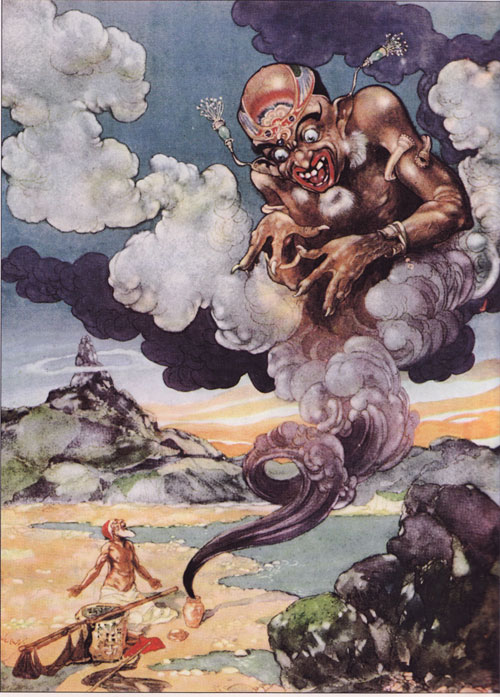
I’ll be honest. The first thing I thought when I looked at this picture was, “Well, that’s racist.” And so it is. The style in which Bull drew the genie uses the visual language of the time, particularly cartoons of people of African descent. I’m going to focus on the picture’s mechanics, but I wanted to acknowledge the racist aspect right up front.
The clear focus of this picture is the genie. While the fisherman is there, he’s small – the genie dwarfs him. We certainly get a grander scale in this picture that we did with the Brundage’s. The sentence accompanying the picture is, “Ah! replied the fisherman, why would you kill me?” Here the fisherman is clearly begging for his life, or at least trying to forestall the inevitable. We see the genie first, but then follow its gaze down to the fisherman. Either the fisherman’s gaze takes us straight back, or our eye goes to the mountain above him that points to the smoke. From there it’s back to the genie.
Bull makes a few different choices in relating the story. His fisherman is poorer than the one in the first picture – he has no shirt and just a wrap for the bottom half. He’s also got more fishing gear. To accommodate the larger scale, our viewpoint is further back and higher up. We’re floating in the air, though not as high as the genie. Bull also uses rock formations to create depth. The foreground rock formation on the lower right echoes the shape of the genie’s smoke (rhythym). The rocks in the background also follow the shape of the billows of smoke. Speaking of the smoke, there are two layers of depth there. The silhouetted billows are further back than the main layer.
While I think that the fisherman’s pose clearly communicates his attitude, I don’t think the genie itself is effective. Maybe it’s the difference in time, but I look at the genie and see someone who isn’t scary but rather goofy, chaotic, and maybe insane. Capricious, perhaps. I see some danger in the situation, but not menace. Partly it’s the drawing style, and partly its the genie’s expression and posture.
Edmund Dulac, 1907
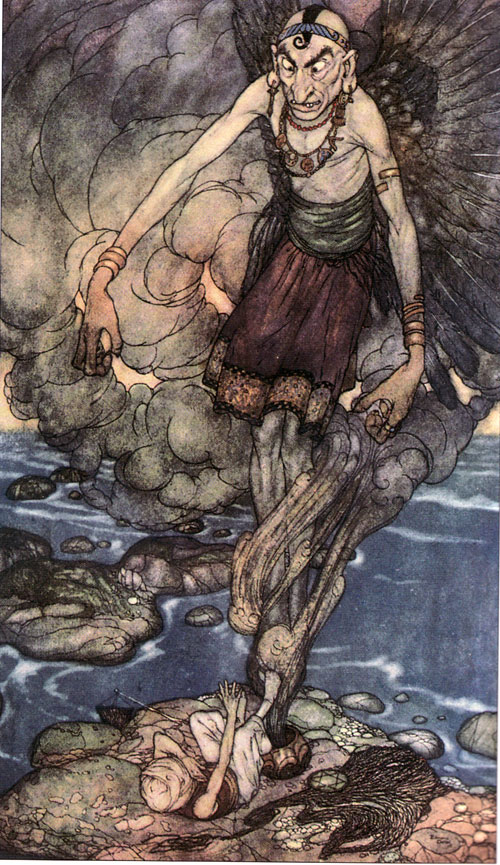
Here we are with the wings again. They’re dark this time, though, and we don’t get to see their full scale. Even more than Bull, this painting’s focus is the genie. We don’t even get to see the fisherman’s face since he’s rolling back on the ground. Our eye level is up with the genie. While the fisherman is a larger part of the picture than Bull’s, he’s more passive and in even less control. We don’t get a good look at his clothing, and the only fishing gear there is the net. One interesting detail I note is the Star of David on the vessel’s lid. Traditionally such things bore the Seal of Solomon to bind the genies. As the genie tells in the story, Solomon gave all of the genies a choice to renounce evil and worship Allah or be sealed in such prisons. I’m not aware of any descriptions of the Seal of Solomon, so I’m guessing that Dulac opted to use the Star of David for it.
It’s hard to judge color on older pieces, but the palette for this one is basically brown with accents of red. The blue of the water and genie’s sashis the other main color. It’s dark and desaturated, but some of that may be the intervening century.
Dulac’s characterization is strong – this genie is definitely menacing. With it’s lanky arms and hands like talons (not to mention wings) the genie evokes a buzzard or bird or prey. Like Bull’s version this genie has jewelry and adornments, but here we can also see clothing and even legs. The trim on the genie’s wrap is cool, though hard to see here. The genie’s expression is certainly more ominous than Bull’s, though the genie isn’t as angry as the one in the Brundage’s picture. Overall I find the picture to be flat – we don’t have foreground, midground, and background elements, and the billows of smoke obscure anything that might give us reference for distance. The viewpoint, though, does help us see the scale.
Charles Folkard, 1913
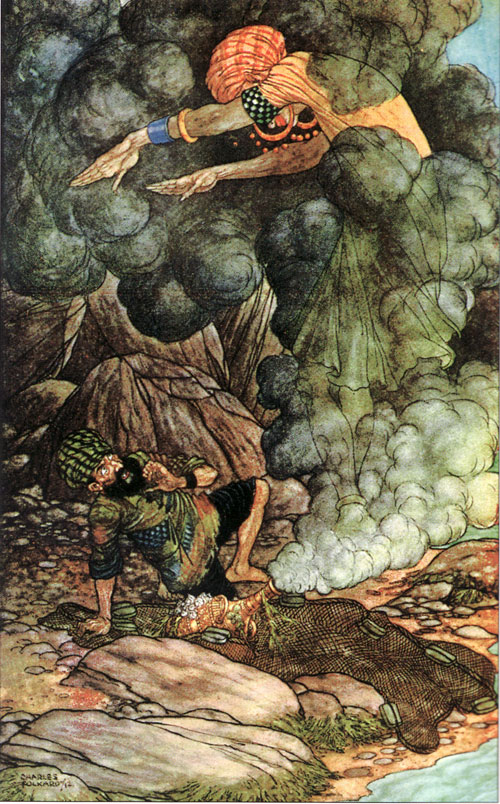
Here we have our first illustration that puts the main focus on the fisherman and not on the genie. We don’t even see it’s face! Even so, the genie is the brightest and most saturated part of the painting. I did look at the genie first and then followed his arms and hands to the fisherman. In this case I say that the painting’s focus is the fisherman because its him we know more about. Frankly, there’s not all that much to look at with the genie, but we have a good look at fisherman’s clothes, posture, and expression. Like the Brundages and Dulac, Folkard uses only a net to symbolize “fisherman.” I particularly like the fisherman’s clothes. They’re grungy and patched together but far from boring. Even his face hints at a hard life. It’s great characterization.
Folkard’s palette is quite similar to Dulac’s – mainly browns and earth tones. The genie provides the only real splash of color with the bright and warm yellow and orange. This painting has a little more depth than Dulac’s due to occlusion – the fisherman is clearly in front of the rocks behind him. Folkard’s genie, though, isn’t nearly as big as Dulac’s and Bull’s.
There are two things that don’t work for me about this illustration. The first is the sense of scale – it’s the same problem I had with the Brundage’s painting. Yeah, the genie is bigger than the fisherman, but towering to the sky? I don’t think so. Second, we don’t get to see the genie itself. It may as well be a sightly larger person. As good a job as Folkard does with the fisherman, the genie completely underwhelms me.
H. J. Ford, 1898
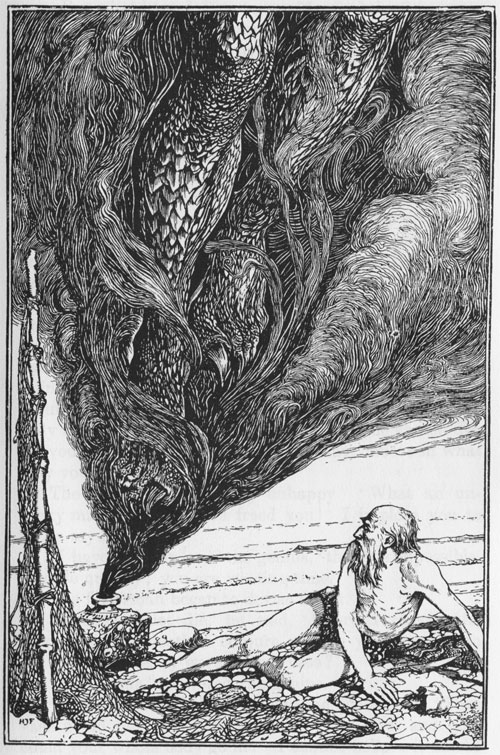
(H. J. Ford has a section in the Arabian Nights book, but this scan comes from a different publication titled The Arabian Nights Entertainments.)
If I wasn’t happy about missing out on the genie’s face in Folkard’s painting, I should be even less satisfied here. However, I’m not. The reason is that although we don’t get a good look at the genie we do get clear hints of the fantastic. There are just hints. I see some claws and talons as well as scales. Or are they feathers? Ford chose to suggest the creature rather than showing it directly, and here it’s effective. It’s a rare horror movie in which the monster lives up to the creepiness of the bulging door.
Ford manages to keep the viewpoint low and the picture contained while still allowing for the genie’s massive scale. Because the smoke continues off the top of the picture, who knows how far up it extends. The genie’s smoke also takes up a majority of the frame we can see. Despite that, it’s the fisherman who is the focus once again. There’s really only one bright spot framed between the genie above and the ground below, and that’s where the fisherman is. His feet point us to the vessel and from there we look at the genie.
Here we have our poorest fisherman yet. He’s only got a loincloth and a skinny, weather beaten body. There’s a wispy beard. As with most of the others it’s the net that lets us know he’s a fisherman, though Ford does include some additional rigging. The rigging, by the way, catches our gaze if we somehow make it past the vessel and redirects it upward into the genie. This genie doesn’t have much in the way of characterization since it’s just a seething mass of smoke and pieces-parts-all-fused.
This is one of my favorites of the pictures here. It’s intimate with the fisherman and hints at the large scale of the genie. Still, despite the intellectual understanding that the genie is huge, we don’t have that massive, epic scale.
Maxfield Parrish, 1909
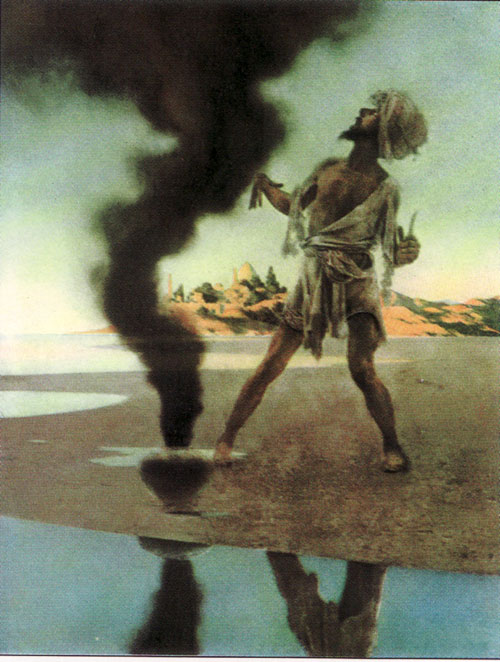
Finally we have the scene as done by Maxfield Parrish. He has chosen to do away with the genie completely and focus only on the fisherman. We see the smoke, but no actual genie. Interestingly, despite the water setting this is the first time we see an actual reflection in the water. The strongest contrast in the picture is the column of smoke and the silhouette of the fisherman. The two join at the fisherman’s hand, and the smoke looms up over the fisherman, framing him.
For this picture, I think Parrish was going more for a comic effect than one of shock and awe. The fisherman is gangly and knock-kneed. His expression shows complete surprise but not fear. It’s a complete WTF moment. The characterization is great. The fisherman’s skinny frame and tattered clothes tell us that he’s poor and I love his posture. The way his hand is hanging limply tickles me for some reason.
There is no sense of epic scale, but Parrish certainly gives us depth with the city in the background and the landscape. It’s not a major part of the picture, but it sets a scene. Unlike most of the others, Parrish shows a sandy beach that has pools calm enough to clearly reflect something. There’s not a rock or a stone in sight in the foreground.
I like this picture as well, though I still have that little thought scampering at the back of my mind that this story is about a genie and I want to see one dammit. I’ll get over it, though. It does show, however, that you don’t always have to go the obvious route with a painting. Sometimes you can paint something by not showing.
The Wrap-Up
So now you know what a genie looks like. Well, sort of. They’re super tall, except for when they’re not. They’re basically human looking, except when they’re just a mass of claws and scales. They only have an upper half to their bodies, except when you can sometimes find their legs. They wear anything from wraps to assassin’s cloaks to nothing at all. The point is that when we illustrate something we have great freedom, but we need to go ahead and make our decisions and thoroughly think things through.
Next week will be a Princely painting by Brian Bolland of Judge Dredd fame among many other feats of art.
(P.S. – So, like I said at the beginning, it’s up to you to decide who wins the cage match. Which of these six illustrations works best for you? Why do you think it’s the most successful? Cast your votes in the comments.)